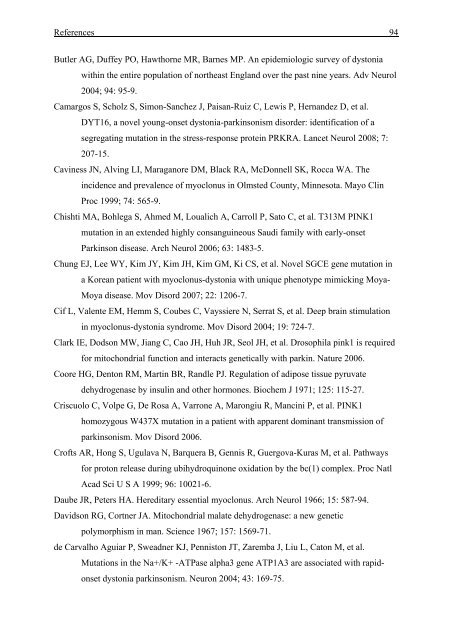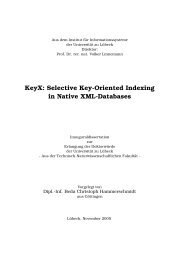Molecular characterisation of SGCE-associated myoclonus-dystonia ...
Molecular characterisation of SGCE-associated myoclonus-dystonia ...
Molecular characterisation of SGCE-associated myoclonus-dystonia ...
You also want an ePaper? Increase the reach of your titles
YUMPU automatically turns print PDFs into web optimized ePapers that Google loves.
References 94<br />
Butler AG, Duffey PO, Hawthorne MR, Barnes MP. An epidemiologic survey <strong>of</strong> <strong>dystonia</strong><br />
within the entire population <strong>of</strong> northeast England over the past nine years. Adv Neurol<br />
2004; 94: 95-9.<br />
Camargos S, Scholz S, Simon-Sanchez J, Paisan-Ruiz C, Lewis P, Hernandez D, et al.<br />
DYT16, a novel young-onset <strong>dystonia</strong>-parkinsonism disorder: identification <strong>of</strong> a<br />
segregating mutation in the stress-response protein PRKRA. Lancet Neurol 2008; 7:<br />
207-15.<br />
Caviness JN, Alving LI, Maraganore DM, Black RA, McDonnell SK, Rocca WA. The<br />
incidence and prevalence <strong>of</strong> <strong>myoclonus</strong> in Olmsted County, Minnesota. Mayo Clin<br />
Proc 1999; 74: 565-9.<br />
Chishti MA, Bohlega S, Ahmed M, Loualich A, Carroll P, Sato C, et al. T313M PINK1<br />
mutation in an extended highly consanguineous Saudi family with early-onset<br />
Parkinson disease. Arch Neurol 2006; 63: 1483-5.<br />
Chung EJ, Lee WY, Kim JY, Kim JH, Kim GM, Ki CS, et al. Novel <strong>SGCE</strong> gene mutation in<br />
a Korean patient with <strong>myoclonus</strong>-<strong>dystonia</strong> with unique phenotype mimicking Moya-<br />
Moya disease. Mov Disord 2007; 22: 1206-7.<br />
Cif L, Valente EM, Hemm S, Coubes C, Vayssiere N, Serrat S, et al. Deep brain stimulation<br />
in <strong>myoclonus</strong>-<strong>dystonia</strong> syndrome. Mov Disord 2004; 19: 724-7.<br />
Clark IE, Dodson MW, Jiang C, Cao JH, Huh JR, Seol JH, et al. Drosophila pink1 is required<br />
for mitochondrial function and interacts genetically with parkin. Nature 2006.<br />
Coore HG, Denton RM, Martin BR, Randle PJ. Regulation <strong>of</strong> adipose tissue pyruvate<br />
dehydrogenase by insulin and other hormones. Biochem J 1971; 125: 115-27.<br />
Criscuolo C, Volpe G, De Rosa A, Varrone A, Marongiu R, Mancini P, et al. PINK1<br />
homozygous W437X mutation in a patient with apparent dominant transmission <strong>of</strong><br />
parkinsonism. Mov Disord 2006.<br />
Cr<strong>of</strong>ts AR, Hong S, Ugulava N, Barquera B, Gennis R, Guergova-Kuras M, et al. Pathways<br />
for proton release during ubihydroquinone oxidation by the bc(1) complex. Proc Natl<br />
Acad Sci U S A 1999; 96: 10021-6.<br />
Daube JR, Peters HA. Hereditary essential <strong>myoclonus</strong>. Arch Neurol 1966; 15: 587-94.<br />
Davidson RG, Cortner JA. Mitochondrial malate dehydrogenase: a new genetic<br />
polymorphism in man. Science 1967; 157: 1569-71.<br />
de Carvalho Aguiar P, Sweadner KJ, Penniston JT, Zaremba J, Liu L, Caton M, et al.<br />
Mutations in the Na+/K+ -ATPase alpha3 gene ATP1A3 are <strong>associated</strong> with rapidonset<br />
<strong>dystonia</strong> parkinsonism. Neuron 2004; 43: 169-75.

















